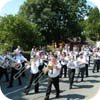Buckley (Welsh: Bwcle) is a town in Flintshire, Wales, United Kingdom. It is the second largest town in Flintshire in terms of population, and is 2 miles from Mold, the county town. It is located on the A549 road, with the larger A55 road and M53 motorway both passing nearby, and is in the Alyn and Deeside parliamentary constituency.
It is contiguous with the nearby villages of Ewloe, Alltami (which are both under the jurisdiction of Buckley district council) and Mynydd Isa.
Notable nearby landmarks include Ewloe Castle.
Buckley (the name comes from the Anglo-Saxon bok lee, meaning meadow, or field) was an Anglo-Saxon location, with some of its houses recorded in the Domesday Book of the 11th Century. However, the first documented evidence of its existence dates from 1294, when it was described as the pasturage of the Manor of Ewloe.
The town became an industrial heartland for pottery and coal between the 17th and 19th centuries. However, it only grew into any kind of prominence during the Industrial Revolution of the 18th Century, when coal and clay were extensively mined there, and the name Buckley became synonymous with the production of various fire-clay and pottery products.
Urban district council status was conferred on the town in 1898; at this time, the area comprised of two parishes, Buckley (1874) and Bistre (1844). Prior to then, it was divided between the parishes of Mold and Hawarden.
Buckley was a popular location for mining, as there were many faults in local rock formations that allowed seams of coal to be mined directly from the surface. Its heavy, clay soil also allowed for excellent pottery and bricks to be manufactured. Bricks from Buckley were transported all across the United Kingdom, as Buckley became a brick working centre. A great deal of people moved into the area, particularly from Ireland and Liverpool to find work in the mining and brick industries, giving the town a distinctive accent..
Many pottery and earthenware products manufactured were taken on the backs of donkeys to either Chester market or exported via the River Dee, as early as the reign of Elizabeth I. The last pottery kiln was fired in 1946. However, a local cement works is still in operation.
Today, Buckley has a population of around 17,000, and boasts numerous light industries. Those who cannot find work locally commute to Deeside, Cheshire, Wrexham and Merseyside.
The Castle Cement works at Padeswood is the only large scale industry remaining in the town. Its huge new 200 ft kiln is now the major landmark on the skyline, visible from many miles away. Despite many locals considering it an eyesore, it has reduced pollution produced by the cement works by up to 90%.
Buckley observes a regional celebration and march over 200 years old called the Buckley Jubilee, which is celebrated on the second Tuesday of July. Officially, however, the Jubilee is 149 years old (as of 2005); the 150th is to be celebrated 11 July 2006. The difference in dates stems from the 'official' date being set when the Buckley Temperance Society first sanctioned the march. The Jubilee is a ceremonial march that begins on "The Common", a large area of common ground owned by the people of the town used for lesuire and recreational purposes. The term 'jubilee' was first used in 1871.
On the Common starting at 3pm is a non-denominational Service led by the Minister of the Church/Chapel leading the Jubilee that year. In 2005, it was the Revd. Anthraparushra. The Sunday before the Jubilee, the leading church is presented with the Centenary Shield, which they hold for the year. A 15 minutes service takes place, with two hymns accompanied by the Royal Buckley Town Band. The march then leaves the common, and marches through the town, with representatives from the local Sunday Schools, Scout and Guide troops, and many of the local schools.
For more information see: http://www.buckleysociety.org.uk/
 Trains: Buckley is on the Borderlands Line Trains: Buckley is on the Borderlands Line |






